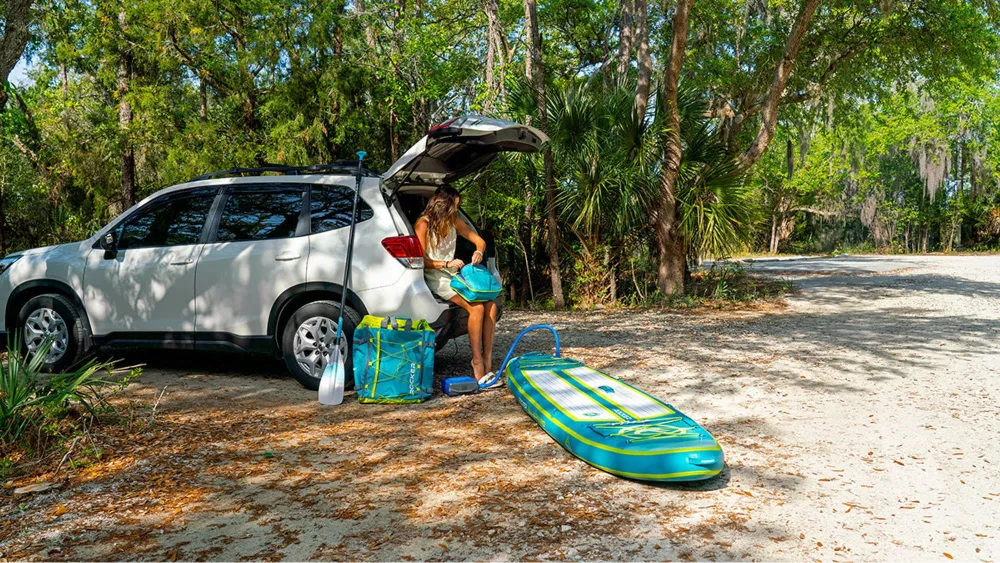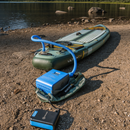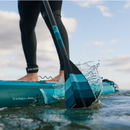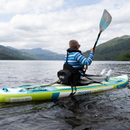Paddle Board PSI: Best Practices for SUP Summer

Are you excited for a fantastic summer of stand-up paddle boarding? The perfect paddle board PSI is crucial to catching those epic waves like a pro. The ideal PSI enhances your performance and provides maximum comfort and stability while shredding your SUP. Our comprehensive guide will share the best practices PSI for paddle board, revealing insider tips to enhance your summer paddling experiences. Let’s get started!
How to Keep your SUP from Feeling the Heat
Long days on the water and in the sun are what summer is all about. But with warm weather conditions come precautions that must be taken to ensure your safety and the safety of your inflatable paddle board. iROCKER boards are built to last, but it’s important to maintain your board and minimize any unnecessary risks.
By following these guidelines, you can ensure that your inflatable SUP and its inflatable paddle board PSI are in top-notch condition for a season of sun-filled adventures.

What PSI Should a Paddle Board Be?
Generally speaking, lighter paddlers (under 180 lbs) can inflate the board to 15-18 PSI, while heavier paddlers (over 180 lbs) should inflate to 15-22 PSI.

Higher PSI, like 15 PSI, can provide more rigidity in cold or choppy conditions. Increasing paddle board PSI also enhances stability. However, it's advisable not to go below 10 PSI, as this may compromise the board's strength and potentially cause creasing under excessive weight. The ideal paddle board PSI balances rigidity and stability without over-inflation.
Paddle Board PSI: Never Overinflate an Inflatable SUP
All iROCKER SUPs are designed to hold a maximum of 23 PSI. However, we recommend you inflate your board to no more than 15 PSI. The most important rule when it comes to inflatable SUPs is applicable no matter the temperature.

There is no added benefit of inflating past 15 PSI and the remaining room at 15 PSI allows the air inside the board to expand should it become heated. If you overinflate your board and then the air heats and expands, it has nowhere to go, which can put excess pressure on the board’s seams and even cause them to fail.
Never Leave an Inflated SUP Out in the Sun
While there is room left in your board at 15 PSI for air to warm and expand, it’s never a good idea to leave your inflated board out in the sun, whether that’s on hot sand at the beach while you take a paddle break or on grass or a dock. If you need to take a break but don’t have access to any shade, let a bit of air out of your board so that the air inside has even more room to expand in the sun. The best practice though is to avoid leaving your inflated board in the sun.
An inflated board that is in direct sunlight but being used on the water should be inflated to 15 PSI as the water will act to cool the air inside the board. No need to let any air out!

Never Leave an Inflated SUP in Your Car
Exposing an inflated paddle board to excessive heat can be detrimental, so it's crucial never to leave an inflated SUP in your car. A vehicle's interior can rapidly heat up by an average of 40 degrees Fahrenheit within an hour, regardless of the outside temperature. Even a car parked in the shade can become scorching hot quickly.
The rapid expansion of air inside your stand up paddle board at the set paddle board PSI can exert excessive pressure on the board's seams, leading to leaks or, in worst-case scenarios, a blown-up board. If you must leave your paddle board in your car, deflate it entirely to ensure no damage occurs to the board or your vehicle.

Experience the perfect summer on the water with our Summer Essentials Collection.
Inflatable paddle boards offer unbeatable convenience, portability, and fun! However, like any outdoor gear, they can endure wear and tear from the elements. If you're ever unsure, the safest approach is to deflate your paddle board from its recommended PSI.
It takes merely 12 minutes to reinflate it to the proper paddle board PSI using an electric pump. Safeguard yourself from the worry and hassle of replacing a board by taking the necessary precautions, ensuring you can create cherished memories on the water for years to come!
For warranty questions regarding heat-related failures and other issues, please visit our Warranty Page.






